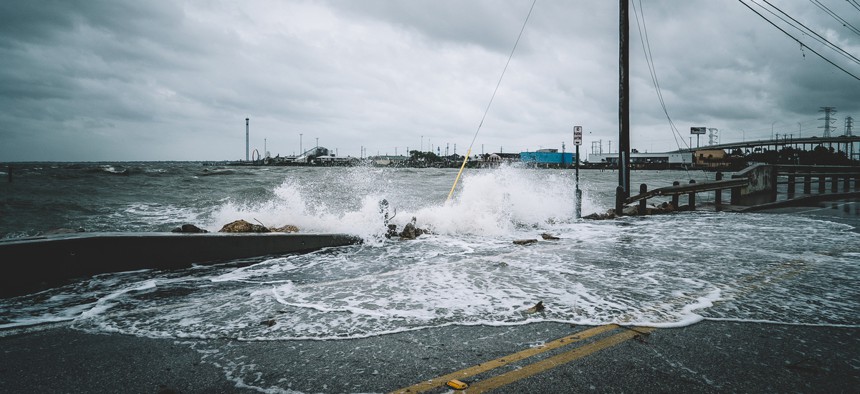Energy Department, Microsoft Set Up Consortium to Produce AI-Enabled Tools for First Responders

Cire notrevo/Shutterstock.com
At least ten partners from across the government, industry and academia have already signed on.
A strategic new effort steered by the Energy Department’s nascent Artificial Intelligence and Technology Office and Microsoft intends to produce and scale artificial intelligence-driven solutions to help first responders’ better counter natural disasters and protect more property and people in the process.
The First Five Consortium—co-chaired by the two and unveiled Tuesday—connects government, industry, academic and non-profit players to share insights, develop code and deploy technological tools to heighten humanitarian and disaster response and relief.
“There are just so many technologies where we can solve some of the toughest problems—at a time and in a moment where we're having an explosion of wildfires and floods and some really major natural disasters,” Director of the Artificial Intelligence and Technology Office, or AITO, Cheryl Ingstad said on a call with reporters Monday. “And we think we can bring AI to bear here to help save lives.”
So far, at least 10 partners signed on to be members of First Five, Nextgov confirmed Tuesday. They include: Esri; AT&T; Hangar Alpha; Pacific Northwest National Laboratory; Pacific Disaster Center; Texas A&M; Berkeley Artificial Intelligence Laboratory—Computer Vision or BAIR-CV; First Net Authority; CrowdAI; the Defense Department; and the National Oceanic and Atmospheric Administration. Organizations looking to get involved can respond via the First Five Portal, which also provides an opportunity for the broader community of first responders to share disaster and relief-related use cases that hold potential for AI to advance.
Specifically, the consortium will underpin collaborations and efforts to apply AI and deep learning to advance research and development topics involving response to natural events like hurricanes and tornadoes, predicting and containing wildfires, assessing damage in impacted areas, and search and rescue efforts. Ingstad noted that Energy will provide technology capabilities to boost and refine new AI tools and the department’s 17 national laboratories can also engage in cooperative agreements “to put the right talent” to work creating and maturing the assets.
The range of budding technology that the consortium is honing in on offers the potential for data gathered in the field in real time to be sent to the cloud and used to provide first responders on the ground invaluable insights that could augment their decisions as they pursue frontline efforts—such as better forecasting the direction the flames of a wildfire will head next. Microsoft Federal Chief Technology Officer Susie Adams said on the call that those responding to threatening natural events could eventually be able to consider heaps of data augmented by newly-crafted AI capabilities and use their own education to determine how to best proceed as crises unfold.
“It really is a gamechanger compared to how people are looking at information today,” Adams said.
The consortium has roots in an executive forum focused on humanitarian assistance and disaster response hosted by White House Deputy Chief of Staff for Policy Coordination Chris Liddell in January, following which Energy has been working to coordinate new disaster-solving opportunities within the response space.
Separately, officials within the Defense Department’s Joint Artificial Intelligence Center have been working with the National Guard for more than a year to build and advance AI-enabled capabilities in fireline detection and flood damage assessment. The JAIC partnered with Energy’s Pacific Northwest National Lab to scale the deep learning prototypes—and their intention is to make a minimum viable product available to the consortium upon completion, which could help further refine it.
Offering a taste of what the to-be-refined solutions can offer, the center's spokesman Navy Lt. Cmdr. Arlo Abrahamson said on the call Monday that through one effort with the California National Guard and the California Department of Forestry and Fire Protection, the JAIC created a tool to provide almost real-time updates of how wildfires escalate in the field. “If you look at the technology that the firefighters were using before, usually they would get an update every hour,” Abrahamson noted.
Through another effort that’s nearing maturity, the JAIC worked with NOAA, FEMA, and others to create an AI-enabled flood and damage assessment capability. The solution uses overhead imagery from satellites and aircraft to pinpoint areas where water has encroached beyond its normal borders.
“The JAIC's work in fielding minimum viable products and testing and improving those capabilities with the feedback of first-responders and end-users has enabled the JAIC to capitalize from technical-lessons-learned and refine processes—and we are sharing this information with the [Energy Department] and our consortium partners to help them take these projects to the next level and scale them for broader deployment across the federal government,” Abrahamson told Nextgov via email Tuesday.
Abrahamson also confirmed that the consortium has not yet “broached the issue” of data governance or a common cloud infrastructure for all consortium solutions, but he noted that insiders will provide updates as the effort matures.
The name “First Five” was coined after the first responder community shared with the consortium’s creators how the first five minutes “is what matters the most in terms of being able to mitigate the impact of whatever that disaster is,” Jermon Bafaty, a White House fellow assigned to Energy, said on the call. He noted that in 2019 alone there were 14 disasters that individually cost over a billion dollars in damage—“and that doesn't even count any loss of life that was associated with that.”
Bafaty told Nextgov over email Tuesday that the ultimate hope is that, one year down the line, solutions for humanitarian and disaster response-related events have been deployed across the nation because of collaboration among First Five participants.
“These solutions would have significantly reduced property loss, and more importantly, loss of life—while equipping our first responder community with tools that enable them to better respond to these events,” Bafaty said.
Editor's note: This article was updated to include more information about the consortium's early members.






